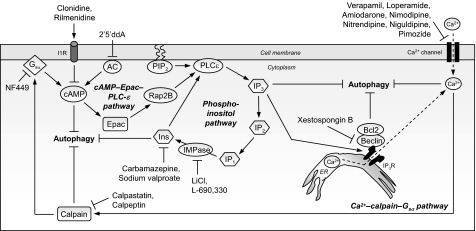FIGURE 3.
Cyclical mTOR-independent autophagy pathway with multiple drug targets for neurodegenerative diseases. Shown is a cyclical mTOR-independent pathway regulating mammalian autophagy, comprising cAMP-Epac-PLCϵ-IP3 and Ca2+-calpain-Gαs pathways, which has multiple drug targets for neurodegenerative diseases. Intracellular cAMP levels are increased by adenylyl cyclase (AC) activity, thus activating Epac, which then activates the small G-protein Rap2B, thereby activating PLCϵ. PLCϵ mediates the production of IP3 from phosphatidylinositol 4,5-bisphosphate (PIP2), thereby increasing the levels of IP3 that binds to ER-resident IP3Rs, leading to release of Ca2+ from the ER stores. Intracytosolic Ca2+ levels are also increased by L-type Ca2+ channel agonists. Elevated intracytosolic Ca2+ activates calpains, which then cleave and activate Gαs. In turn, activation of Gαs increases adenylyl cyclase activity to elevate cAMP levels, thereby forming a loop. Activation of this pathway inhibits autophagy. Multiple drug targets acting at distinct stages in this pathway trigger autophagy, such as imidazoline-1 receptor (I1R) agonists (clonidine and rilmenidine) and the adenylyl cyclase inhibitor 2′,5′-dideoxyadenosine (2′5′ddA), which decrease cAMP levels; agents that lower inositol (Ins) and IP3 levels (carbamazepine and sodium valproate); IMPase inhibitors that also reduce inositol and IP3 levels (lithium and L-690,330); Ca2+ channel blockers (verapamil, loperamide, amiodarone, nimodipine, nitrendipine, niguldipine, and pimozide); calpain inhibitors (calpastatin and calpeptin); and the Gαs inhibitor NF449. Furthermore, inhibition of the IP3R by xestospongin B also induces autophagy by disrupting the IP3R-beclin 1 complex and, consequently, the Bcl-2-beclin 1 autophagy inhibitory complex. Enhancing autophagy through this mTOR-independent pathway is protective in various models of HD.

